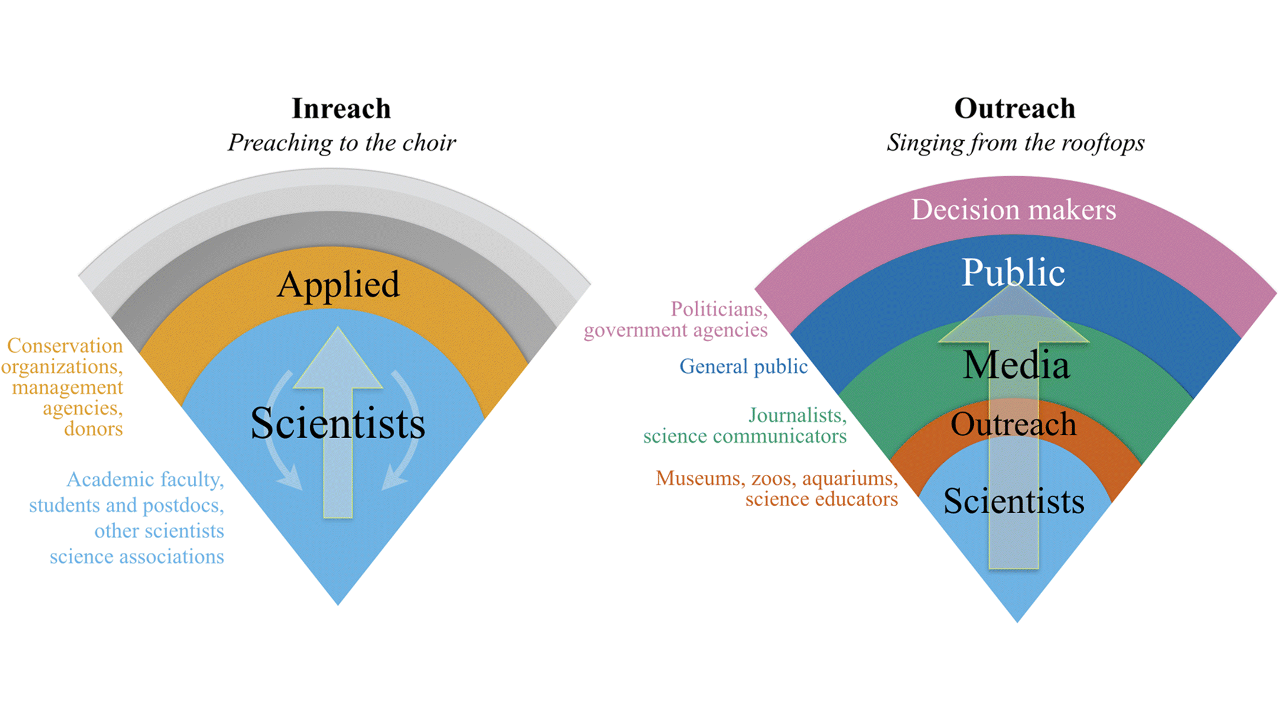
Scientists on Twitter: Preaching to the choir or singing from the rooftops? [Top 100 journal articles of 2018]
This article is part 4 of a series reviewing selected papers from Altmetric’s list of the top 100 most-discussed journal articles of 2018.
Previous research has shown that Twitter is a medium of choice for science communication. But how effective is Twitter as a tool for transferring scientific knowledge to the general public and decision makers?
The authors of a June 2018 paper1 ask whether Twitter allows scientists to promote their findings primarily to other scientists (“inreach”), or whether it can help them reach broader, non-scientific audiences (“outreach”). To answer this question, they analyzed the Twitter followers of more than 100 faculty members in ecology and evolutionary biology. A conceptual depiction of “inreach” and “outreach” is shown in the image above.
They found that scientists on Twitter start by having more scientist than non-scientist followers, meaning that they are largely preaching to other scientists in an “inreach” echo chamber. However, beyond a threshold of 1000 followers, the tweets of scientists reach a more varied audience that is composed primarily of non-scientists, meaning that Twitter then has the potential to function as an “outreach” tool.
Following on from their findings, the authors provide the following advice to scientists in regard to building a Twitter following and engaging with their Twitter followers:
In general, people who tweet more have more followers. Whether causal or simply correlational, the strength of this association is nevertheless variable and generally low … Moreover, the size of the following does not reflect how much followers engage with a user’s tweets, for example by retweeting. For audience engagement, content matters. Tweets that contain hyperlinks and hashtags are more likely to be retweeted, as are tweets that contain images. Even more important for the likelihood of being retweeted is the topical relevance of the tweet to the follower, which speaks to the need for scientists to make their message matter to their intended audiences. One final important lesson is that ordinary users that become influential (i.e., that are mentioned and (or) retweeted frequently) tend to limit their tweets to narrow topics. Thus, although Twitter influence can be gained accidentally because of timing, circumstance, or emotion, it is more often the result of concerted and persistent effort.
Author abstract
There have been strong calls for scientists to share their discoveries with society. Some scientists have heeded these calls through social media platforms such as Twitter. Here, we ask whether Twitter allows scientists to promote their findings primarily to other scientists (“inreach”), or whether it can help them reach broader, non-scientific audiences (“outreach”). We analyzed the Twitter followers of more than 100 faculty members in ecology and evolutionary biology and found that their followers are, on average, predominantly (∼55%) other scientists. However, beyond a threshold of ∼1000 followers, the range of follower types became more diverse and included research and educational organizations, media, members of the public with no stated association with science, and a small number of decision-makers. This varied audience was, in turn, followed by more people, resulting in an exponential increase in the social media reach of tweeting academic scientists. Tweeting, therefore, has the potential to disseminate scientific information widely after initial efforts to gain followers. These results should encourage scientists to invest in building a social media presence for scientific outreach.
Header image source: Côté & Darling 2018.
Reference:
- Côté, I. M., & Darling, E. S. (2018). Scientists on Twitter: Preaching to the choir or singing from the rooftops?. FACETS, 3(1), 682-694. ↩
Also published on Medium.





